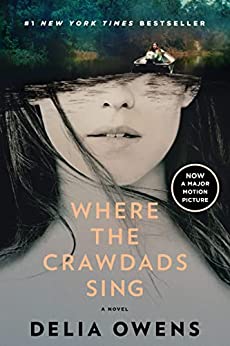Where The Crawdads Sing by Delia Owens
Delia Owens‘ 2018 novel, Where The Crawdads Sing (Penguin Publishing Group), one of the bestselling books of all time, is at its heart an empowering tale of a girl who survives. Left by her family to fend for herself, a young white girl grows up in 1950s coastal North Carolina, an endless expanse of swamp and marsh. Defying odds at every turn, Catherine “Kya” Clark learns to survive on her own, transcends her illiteracy to become a published author, and even finds love despite being an outsider so misunderstood and despised by her community that she is accused of murdering her former lover — in spite of a lack of any evidence.
In her debut novel, Owens presents us with a feral coming-of-age story that deals heavily with trauma and fear, but balances it out with more than a fair share of heart, hope, forgiveness and perseverance. It’s not hard to see why the book has sold over 12 million copies, or why Reese Witherspoon not only included it in her book club, but decided to adapt it to the big screen. While book-to-screen adaptations are often forgettable at best, this film faithfully preserves the fantasy of innocent perseverance created by the book and brings it to life in stunning, salty, mud-splattered detail.
AN EMPOWERING TALE OF A GIRL WHO SURVIVES
Like the book, the film follows two timelines. The first takes place in 1969 and follows Kya as she is put on trial for the murder of the town’s resident rich, preppy white boy, Chase Andrews. The second timeline, taking place in the 1950s, makes up the bulk of the film, and consists of Kya’s recounting of her wild childhood to her kindly defense lawyer, Tom Milton.
Although for much of the film, the swamp is the only companion Kya believes she needs, one of the film’s greatest strengths lies in the bonds she develops with the select few who prove worthy of her love. Jumpin, a wharf gas station owner, and his wife Mabel are two of Kya’s biggest supporters. Despite their constant maintenance of a respectful distance from Kya’s life, the two do their best to support her at every opportunity, from Mabel giving a young Kya extra food and a pair of shoes, to Jumpin buying the mussels Kya gathers, and the both of them keeping land developers away from Kya’s property. It’s a pleasure watching Jumpin’s initial mantra of “stay outta other folks’ business” break down in the face of an almost fatherly concern for her well-being.
A FAITHFUL PRESERVATION OF THE BOOK’S FANTASY
Even more important to Kya’s development is childhood friend Tate Walker. Tate teaches Kya to read, acts as a constant touchstone to the rest of society and perhaps most importantly, teaches her to love. Kya and Tate’s relationship is the strongest point of the film, as I felt it highlighted the growth of Kya’s character. Kya is betrayed by a bevy of people throughout the book, including her family, the town and the vile Chase Andrews. Because of this, when Tate initially leaves for college, Kya feels let down yet again. What Kya doesn’t understand initially, however, is that there is so much more to life beyond the swamp, if only she would reach for it.
Tate’s departure and return help her come to terms with this, as Kya eventually takes his advice, submits her scientific drawings to a publishing house and lands a big deal, setting up what becomes her career.
Actors Taylor John Smith (Tate) and Daisy Edgar-Jones (Kya) do an exquisite job of bringing these characters to life, particularly through body language and intimate moments. Edgar-Jones’ ability to depict a character at once both hauntingly fragile and resilient as one raised by the wild is nothing short of extraordinary. Smith plays off of this remarkably well, and makes it clear that although Tate is torn between his desire for a higher station in life and that of a life with Kya, the one thing he is sure of is his love for her, and that he will find a way.
A MUST-VIEW FOR FANS OF ANY GENRE
North Carolina marshland (filmed in coastal Louisiana) is simply beautiful. The book is known in part for its stunning and immersive imagery, and the film more than does this justice. Grand sunsets, vast coastlines, and the thriving ecosystem of the marshes are brought to life in all their glory, so much so that I’m eager to go and see it for myself. Equally as beautiful in my eyes are the less picturesque elements: the squelching mud; the sweat; digging shellfish out of the ground at the crack of dawn; seemingly ancient, single-engine dingies puttering peacefully down quiet channels. Whereas the more scenic elements feel right at home in the movie, the grittier ones make me feel as if I’m living in it.
Where the Crawdads Sing stands alone just as well for those new to the story as it does for avid fans. Touching and well-developed relationships paired with evocative performances by the leads and stunning cinematography make this a must-view for fans of any genre. Where the Crawdads Sing spreads its wings and rises above the typical mediocrity of book-to-screen films, gliding elegantly along the marsh just as the herons do.





